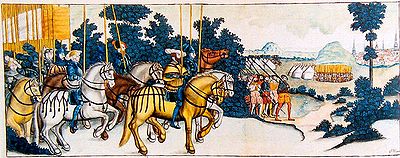- Dacke War
-
Dackefejden (English: The Dacke feud or Dacke war) was a peasant uprising led by Nils Dacke in Småland, Sweden, in 1542 against the rule of Gustav Vasa. Dacke and his followers were dissatisfied with the heavy burden of the taxes, the introduction of lutheranism and the confiscations of the churches property. In 1543 the uprising was crushed, and Nils Dacke killed.
Contents
Background
See also: Early Vasa eraNils Dacke and his peasants were dissatisfied with the policies of the king Gustav Vasa. In his effort to modernize Sweden and gain more power, the king had instituted a more efficient system for tax collection. The heavy burden of the taxes angered many peasants.
Gustav Vasa had also broken relations with Rome and promoted lutheranism instead of Catholicism, to be able to confiscate the properties of the church. In 1541 the kings men had confiscated many of the belongings of the churches in Småland, such as the church silver and even the church bells, to finance the army. Dacke criticised the new church order and promoted the old faith. He was also supported by many local priests.
The rebellion was one of many rebellions during the rule of Gustav Vasa. In contrast with other contemporary rebellions in Sweden, this one was led by peasants, and not supported by the local nobility.
The uprising
The uprising began in the summer of 1542 when the king's bailiffs were attacked and killed when they came to collect taxes. Gustav Vasa responded by sending a military force led by his own father-in-law Gustav Olovsson Stenbock. His attempt to crush the rebellion failed, and he was defeated by Dacke's constantly growing army of peasants. Other attempts to defeat Dacke militarily also failed.
Instead all supplies of provision and other necessities to the region were stopped. This weakened the rebellions considerably. Defaming propaganda about Dacke was also spread, labelling him a traitor and a heretic.
In March 1543 Gustav Vasa ordered his army of Swedish recruits and German landsknecht mercenaries to attack Småland. This time bigger forces were deployed, and Dacke's forces were attacked from two directions - from Östergötland and Västergötland. The uprising was crushed, and Dacke was wounded but managed to flee.
Aftermath
The king's revenge on the instigators of the rebellion was hard. The leaders that were caught were executed together with the priests who had supported Dacke. Peasants who had supported the rebellion were deported to Finland, where they had to serve in the army, and the counties where the rebellion had taken place had to pay a big fine to the king.
Dacke himself was caught and killed in August 1543 when trying to escape the country. According to legend, his body was taken to Kalmar, where his head was publicly displayed wearing a crown of copper, as a warning to others.
The rebellion had been the most serious threat to the rule of Gustav Vasa, but after having defeated it he managed to consolidate his power, concentrating more and more power at the hands of the monarch.
See also
- Early Vasa era
- Gustav Vasa
- History of Sweden
- Nils Dacke
Reference in common language
In common language, an event that has not occurred in a reasonable time is often referred to something that "hasn't happened since the Dacke War". This expression is especially common in the southern parts of Sweden but is also used elsewhere.
References
- Dacke War, Encyclopaedia Britannica
- "Den tyska perioden och Dackefejden - 1538-1543" (in Swedish). Örjan Martinsson. http://www.tacitus.nu/svenskhistoria/kungar/vasa/gv-5.htm. Retrieved 2007-12-27.
- Lindkvist, Thomas; Sjöberg, Maria (2006) (in Swedish). Det svenska samhället 800-1820: Klerkernas och adelns tid. Studentlitteratur.
Categories:- Conflicts in 1542
- Swedish rebellions
- Popular revolt in late-medieval Europe
- Wars involving Sweden
- 1542 in Sweden
- 1542 in Europe
- 16th century in Sweden
- Peasant revolts
Wikimedia Foundation. 2010.

